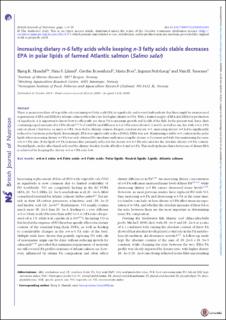| dc.contributor.author | Hundal, Bjørg Kristine | |
| dc.contributor.author | Liland, Nina Sylvia | |
| dc.contributor.author | Rosenlund, Grethe | |
| dc.contributor.author | Bou, Marta | |
| dc.contributor.author | Stubhaug, Ingunn | |
| dc.contributor.author | Sissener, Nini | |
| dc.date.accessioned | 2020-11-18T13:36:07Z | |
| dc.date.available | 2020-11-18T13:36:07Z | |
| dc.date.created | 2020-11-04T10:55:08Z | |
| dc.date.issued | 2020 | |
| dc.identifier.citation | British Journal of Nutrition. 2020, 1-16. | en_US |
| dc.identifier.issn | 0007-1145 | |
| dc.identifier.uri | https://hdl.handle.net/11250/2688504 | |
| dc.description.abstract | There is an increased use of vegetable oils containing n-6 fatty acids (FA) in aquafeeds, and several trials indicate that there might be an increased requirement of EPA and DHA for Atlantic salmon when they are fed higher dietary n-6 FA. With a limited supply of EPA and DHA for production of aquafeeds, it is important to know how to efficiently use these FA to maintain growth and health of the fish. In the present trial, three diets containing equal amounts of n-3 FA (about 7·7 % of total FA) and different n-6:n-3 FA ratios (about 1, 2 and 6), as well as one diet with n-6:n-3 FA ratio at about 1 but twice as much n-3 FA, were fed to Atlantic salmon. Despite constant dietary n-3, increasing dietary n-6 led to significantly reduced n-3 in tissue polar lipids. Interestingly, EPA was significantly reduced while DHA was not. Maintaining a stable n-3 content in the polar lipids when increasing dietary n-6 FA was only obtained by simultaneously increasing the dietary n-3 content and with this maintaining the same n-6:n-3 FA ratio. Polar lipid n-6 FA in tissues thus primarily reflected the dietary n-6:n-3 FA ratio and not the absolute dietary n-6 FA content. Neutral lipids, on the other hand, reflected the dietary absolute levels of both n-3 and n-6 FA. This study indicates that a better use of dietary EPA is achieved by keeping the dietary n-6:n-3 FA ratio low. | en_US |
| dc.language.iso | eng | en_US |
| dc.title | Increasing dietary n-6 FA while keeping n-3 FA stable decreases EPA in polar lipids of farmed Atlantic salmon (Salmo salar) | en_US |
| dc.type | Peer reviewed | en_US |
| dc.type | Journal article | en_US |
| dc.description.version | publishedVersion | en_US |
| dc.source.pagenumber | 1-16 | en_US |
| dc.source.journal | British Journal of Nutrition | en_US |
| dc.identifier.doi | 10.1017/S0007114520002494 | |
| dc.identifier.cristin | 1844814 | |
| dc.relation.project | Fiskeri- og havbruksnæringens forskningsfinansiering: 901282 | en_US |
| dc.relation.project | Norges forskningsråd: 273215 | en_US |
| cristin.ispublished | true | |
| cristin.fulltext | original | |
| cristin.qualitycode | 1 | |
